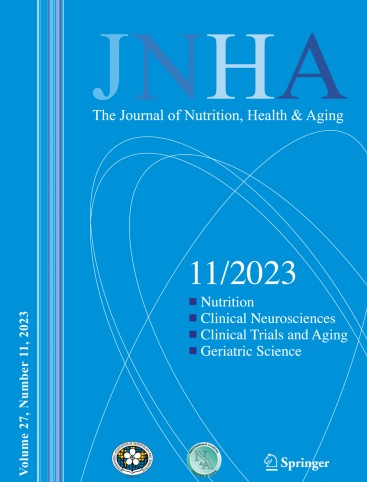Anticholinergic drug exposure is associated with prevalence, worsening and incidence of dysphagia among hospitalized older adults
IF 4.3
3区 医学
Q1 GERIATRICS & GERONTOLOGY
引用次数: 0
Abstract
Objectives
In this study, we aimed at evaluating the association between anticholinergic drug exposure and prevalence, worsening, and incidence of dysphagia among hospitalized older individuals.
Design and setting
We used data from the REPORT-Age project, a multicenter cohort study including patients aged 65 years or more, admitted to acute care hospitals of the Italian National Institute for Health and Sciences on Aging (INRCA-IRCCS) between 2011 and 2019.
Participants
4,005 older patients aged 84.7 (SD = 6.6) years underwent comprehensive geriatric examination according to the interRAI minimum dataset for acute care (MDS-AC), at both hospital admission and discharge.
Measurements
Both prevalence and severity of dysphagia were assessed through items of subjective evaluation included in the section K3 of MDS-AC questionnaire; the anticholinergic drug exposure was measured by means of CRIDECO Anticholinergic Load Scale (CALS) and Anticholinergic Cognitive Burden (ACB) scales. Next, we used logistic regression models to evaluate the association between anticholinergic burden and prevalence of dysphagia at hospital admission; Kaplan Meier cumulative probability curves and cox proportional hazard models were used to analyze the association between anticholinergic burden at hospital admission and worsening or incidence of dysphagia during hospital stay.
Results
Out of 4,005 patients included, 1,070 (30%) presented dysphagia at hospital admission. High anticholinergic burden was associated with increased prevalence of dysphagia at hospital admission (p < 0.001). Moreover, patients with high anticholinergic burden (ACB and CALS ≥ 2) were at increased risk of dysphagia worsening during hospital stay (HR, 95%CI: 1.14, 1.06−1.22 and 1.12, 1.03−1.23 for ACB and CALS respectively). Among the 2,935 patients with normal swallowing function at hospital admission, high anticholinergic burden was associated with the incidence of dysphagia at hospital discharge (HR, 95% CI: 1.89, 1.21−2.96 and 1.86, 1.14−3.06 for ACB and CALS respectively). Development of dysphagia during hospital stay was associated with a reduced prescription of anticholinergic medications (ORs, 95% CI 1.13 (1.07–1.20) and 1.08 (1.01–1.15) for ACB and CALS, respectively).
Conclusions
Increased anticholinergic burden was associated with the prevalence, worsening, and incidence of dysphagia among older hospitalized patients.
抗胆碱能药物暴露与住院老年人吞咽困难的患病率、恶化和发生率有关
目的在本研究中,我们旨在评估抗胆碱能药物暴露与住院老年人吞咽困难的患病率、恶化和发生率之间的关系。设计和设置我们使用的数据来自REPORT-Age项目,这是一项多中心队列研究,包括2011年至2019年在意大利国家老龄化健康与科学研究所(INRCA-IRCCS)急症护理医院住院的65岁及以上患者。根据interRAI急性护理最低数据集(MDS-AC), 4,005名年龄为84.7 (SD = 6.6)岁的老年患者在入院和出院时接受了全面的老年检查。测量方法通过MDS-AC问卷K3部分主观评价项目评估吞咽困难的患病率和严重程度;采用CRIDECO抗胆碱能负荷量表(CALS)和抗胆碱能认知负担量表(ACB)测定抗胆碱能药物暴露情况。接下来,我们使用logistic回归模型来评估住院时抗胆碱能负担与吞咽困难患病率之间的关系;采用Kaplan Meier累积概率曲线和cox比例风险模型分析住院时抗胆碱能负担与住院期间吞咽困难恶化或发生率的关系。结果纳入的4005例患者中,1070例(30%)在入院时出现吞咽困难。高抗胆碱能负荷与住院时吞咽困难患病率增加有关(p < 0.001)。此外,抗胆碱能负担高(ACB和CALS≥2)的患者住院期间吞咽困难恶化的风险增加(HR, 95%CI分别为:1.14、1.06 ~ 1.22和1.12、1.03 ~ 1.23)。入院时吞咽功能正常的2935例患者中,高抗胆碱能负荷与出院时吞咽困难的发生率相关(相对危险度,95% CI分别为ACB和CALS的1.89、1.21 ~ 2.96和1.86、1.14 ~ 3.06)。住院期间吞咽困难的发生与抗胆碱能药物处方的减少有关(ORs, 95% CI分别为ACB和CALS的1.13(1.07-1.20)和1.08(1.01-1.15)。结论抗胆碱能负荷的增加与老年住院患者吞咽困难的患病率、恶化程度和发生率有关。
本文章由计算机程序翻译,如有差异,请以英文原文为准。
求助全文
约1分钟内获得全文
求助全文
来源期刊
CiteScore
7.80
自引率
3.40%
发文量
136
审稿时长
4-8 weeks
期刊介绍:
There is increasing scientific and clinical interest in the interactions of nutrition and health as part of the aging process. This interest is due to the important role that nutrition plays throughout the life span. This role affects the growth and development of the body during childhood, affects the risk of acute and chronic diseases, the maintenance of physiological processes and the biological process of aging. A major aim of "The Journal of Nutrition, Health & Aging" is to contribute to the improvement of knowledge regarding the relationships between nutrition and the aging process from birth to old age.

 求助内容:
求助内容: 应助结果提醒方式:
应助结果提醒方式:


